This article needs additional citations for verification .(December 2009) |


PTAB (Russian ПТАБ, short for Противотанковая Авиабомба, "Antitank Aviation Bomb") was a Soviet World War II high-explosive anti-tank (HEAT) shaped charge bomb.
This article needs additional citations for verification .(December 2009) |


PTAB (Russian ПТАБ, short for Противотанковая Авиабомба, "Antitank Aviation Bomb") was a Soviet World War II high-explosive anti-tank (HEAT) shaped charge bomb.
The bomb was designed within a case of a 2.5 kg bomb, with a case weight of 1.5 kg and 0.62 kg of explosives. The Ilyushin Il-2 ground attack aircraft could carry 280 PTAB bombs directly on the bomb-bay folds, or 4x48 in four cassettes. The PTAB 2.5 could penetrate 60 to 70 millimeter tank armor, at the time sufficient for the top armor of even heavy tanks.
Introduced in 1943, PTABs were widely deployed from Il-2s, [1] and due to the bomb's very low weight, from Yakovlev Yak-9 fighters, specifically from the internal weapon bay in the Yak-9B (fighter-bomber) modification. The Polikarpov Po-2 could also carry and deploy PTABs.
The number of PTABs dropped in a given time period steadily increased thereafter. By the end of 1943, Soviet records show that 1,171,340 PTABs were dropped. In 1944, the number rose to 5,024,822. In the first four months of 1945, a further 3,242,701 PTABs were used. [2]
During the 2022 Russian invasion of Ukraine, rapid technology development occurred to iterate on design of racing drones into a type of FPV loitering munition. Aimed a very low-cost and high production volume, the heavy-duty version of the Escadrone attack drone was modified to carry a 2 kg (4.4 lb) PTAB 2.5 anti-tank bomb. While much less effective than the larger and more expensive Javelin weapon system, it is highly effective against a tank's weak spots. The Escadrone attack drone is maneuverable and has been shown to successfully attack less protected places in Russian tanks. [3]
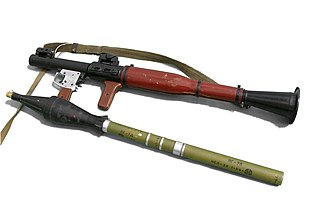
A rocket-propelled grenade (RPG) is a shoulder-fired rocket weapon that launches rockets equipped with an explosive warhead. Most RPGs can be carried by an individual soldier, and are frequently used as anti-tank weapons. These warheads are affixed to a rocket motor which propels the RPG towards the target and they are stabilized in flight with fins. Some types of RPG are reloadable with new rocket-propelled grenades, while others are single-use. RPGs are generally loaded from the front.
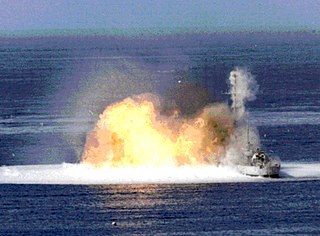
A thermobaric weapon, also called an aerosol bomb, or a vacuum bomb, is a type of explosive munition that works by dispersing an aerosol cloud of gas, liquid or powdered explosive. The fuel is usually a single compound, rather than a mixture of multiple molecules. Many types of thermobaric weapons can be fitted to hand-held launchers, and can also be launched from airplanes.
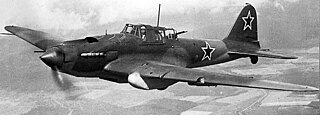
The Ilyushin Il-2 is a ground-attack plane that was produced by the Soviet Union in large numbers during the Second World War. The word shturmovík, the generic Russian term for a ground-attack aircraft, became a synecdoche for the Il-2 in English sources, where it is commonly rendered Shturmovik, Stormovik and Sturmovik.
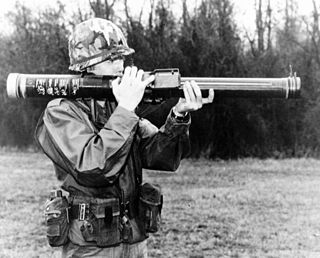
Anti-tank warfare originated during World War I from the desire to develop technology and tactics to destroy tanks. After the Allies deployed the first tanks in 1916, the German Empire introduced the first anti-tank weapons. The first developed anti-tank weapon was a scaled-up bolt-action rifle, the Mauser 1918 T-Gewehr, that fired a 13.2 mm cartridge with a solid bullet that could penetrate the thin armor used by tanks at that time and destroy the engine or ricochet inside, killing occupants. Because tanks represent an enemy's strong force projection on land, military strategists have incorporated anti-tank warfare into the doctrine of nearly every combat service since. The most predominant anti-tank weapons at the start of World War II in 1939 included the tank-mounted gun, anti-tank guns and anti-tank grenades used by the infantry, and ground-attack aircraft.

The Yakovlev Yak-38 was Soviet Naval Aviation's only operational VTOL strike fighter aircraft in addition to being its first operational carrier-based fixed-wing aircraft. It was developed specifically for, and served almost exclusively on, the Kiev-class aircraft carriers.

A general-purpose bomb is an air-dropped bomb intended as a compromise between blast damage, penetration, and fragmentation in explosive effect. They are designed to be effective against enemy troops, vehicles, and buildings.

The Yakovlev Yak-9 is a single-engine, single-seat multipurpose fighter aircraft used by the Soviet Union and its allies during World War II and the early Cold War. It was a development of the robust and successful Yak-7B fighter, which was based in turn on the tandem-seat advanced trainer known as the Yak-7UTI. The Yak-9 started arriving in Soviet fighter regiments in late 1942 and played a major role in retaking air superiority from the Luftwaffe's new Focke-Wulf Fw 190 and Messerschmitt Bf 109G fighters during the grand Battle of Kursk in summer 1943.
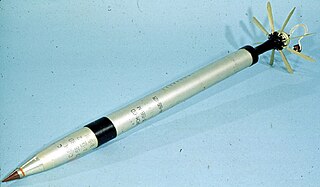
The S-5 is a rocket weapon developed by the Soviet Air Force and used by military aircraft against ground area targets. It is in service with the Russian Aerospace Forces and various export customers. It is based on the R4M, a German design from World War 2.
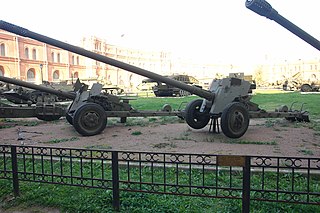
2A19 or T-12 is a Soviet-designed 100-mm anti-tank gun. It was the first anti-tank gun to adopt a smoothbore barrel, and to introduce modern armor piercing shot, like the APFSDS. It uses long projectiles that are more powerful than its caliber suggests. The T-12 served as the primary towed anti-tank artillery in the Soviet and Bulgarian armies from the early 1960s to the late 1980s.

RKG-3 is a series of Soviet anti-tank hand grenades. It superseded the RPG-43, RPG-40 and RPG-6 series, entering service in 1950. It was widely used in the 1973 Arab–Israeli War and remained a common weapon into the 2000s and early 2010s, being favoured by Iraqi insurgents during the American-led occupation. Modified versions of the RKG-3 series have also emerged in the Russian invasion of Ukraine.
RS-82 and RS-132 were unguided rockets used by Soviet military during World War II.
The Volkov-Yartsev VYa-23 is a 23 mm (0.91 in) autocannon, used on Soviet aircraft during World War II.

Slat armor, also known as bar armor, cage armor, and standoff armor, is a type of vehicle armor designed to protect against high-explosive anti-tank (HEAT) attacks, as used by anti-tank guided missiles (ATGMs) and rocket-propelled grenades (RPGs).

A precision-guided munition (PGM), also called a smart weapon, smart munition, or smart bomb, is a guided munition intended to hit a specific target, to minimize collateral damage and increase lethality against intended targets. During the Persian Gulf War guided munitions accounted for only 9% of weapons fired, but accounted for 75% of all successful hits. Despite guided weapons generally being used on more difficult targets, they were still 35 times more likely to destroy their targets per weapon dropped.

The AeroVironment Switchblade is a miniature loitering munition designed by AeroVironment and used by several branches of the United States military. Small enough to fit in a backpack, the Switchblade launches from a tube, flies to the target area, and crashes into its target while detonating its explosive warhead. The name Switchblade comes from how the spring-loaded wings are folded inside a tube and flipped out once released.
Drone warfare is a form of aerial warfare or marine warfare using unmanned combat aerial vehicles (UCAV) or weaponized commercial unmanned aerial vehicles (UAV). The United States, United Kingdom, Israel, China, South Korea, Iran, Iraq, Italy, France, India, Pakistan, Russia, Turkey, Ukraine and Poland are known to have manufactured operational UCAVs as of 2019.
The Shpitalny Sh-37 was the first indigenous Soviet 37 mm (1.5 in) aircraft cannon, designed by Boris Shpitalniy at OKB-15. The gun saw limited production and was installed in few aircraft before being replaced by the competing Nudelman-Suranov NS-37 designed at OKB-16. It was installed on a military-trial basis on two short series of aircraft. Installed to fire through the hollow, gear-driven propeller shaft and fastened to the engine block of the Yak-7-37 it was known as MPSh-37, where "MP" stands for "motornaya pushka", similar to the German Motorkanone term for the same mount type. As installed in the underwing gun pods of the Il-2 it was known as ShFK-37, literally "Shpitalny fuselage-wing(-mounted) caliber 37mm".

A loitering munition, also known as a suicide drone, kamikaze drone, or exploding drone, is a kind of aerial weapon with a built-in warhead that is typically designed to loiter around a target area until a target is located, then attack the target by crashing into it. Loitering munitions enable faster reaction times against hidden targets that emerge for short periods without placing high-value platforms near the target area and also allow more selective targeting as the attack can be changed mid-flight or aborted.

The R18 is a Ukrainian unmanned combat aerial vehicle designed to attack enemy targets with ammunition. It was developed by Ukrainian organization Aerorozvidka. The R18 is in service with the Security and Defense Forces of Ukraine in the Russo-Ukrainian War, which has been ongoing since 2014.
Escadrone is a non-profit group organized in Ukraine during 2022 in order to manufacture FPV attack drones, a type of FPV loitering munition. The business goal was to design and build a large quantity of low-cost drones, aiming specifically to be able to carry anti-tank grenades to the target: tanks and other armored vehicles as well as less-armored military vehicles.